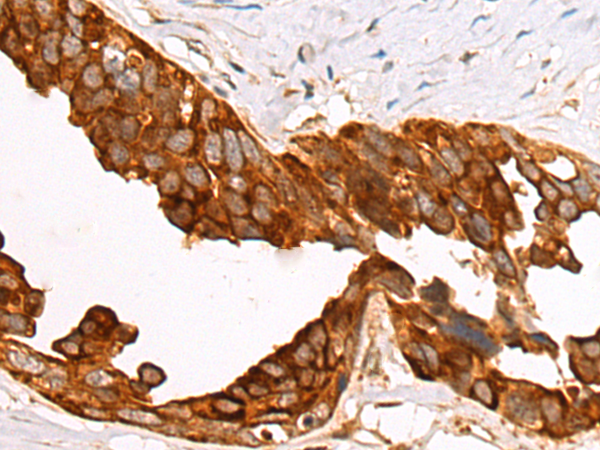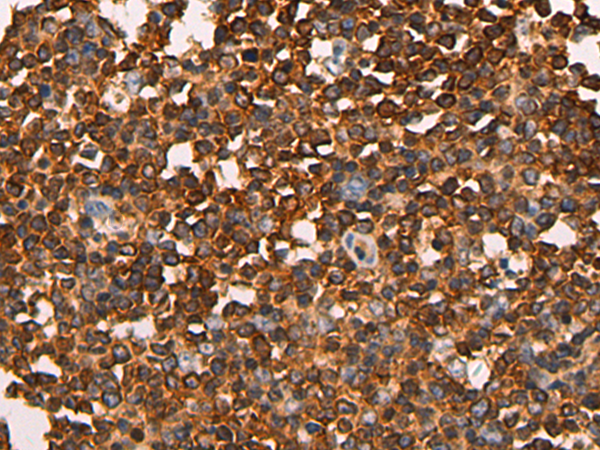


| WB | 咨询技术 | Human,Mouse,Rat |
| IF | 咨询技术 | Human,Mouse,Rat |
| IHC | 1/100-1/300 | Human,Mouse,Rat |
| ICC | 技术咨询 | Human,Mouse,Rat |
| FCM | 咨询技术 | Human,Mouse,Rat |
| Elisa | 1/5000-1/10000 | Human,Mouse,Rat |
| Aliases | RHOBP; P76RBE |
| WB Predicted band size | 77 kDa |
| Host/Isotype | Rabbit IgG |
| Antibody Type | Primary antibody |
| Storage | Store at 4°C short term. Aliquot and store at -20°C long term. Avoid freeze/thaw cycles. |
| Species Reactivity | Human, Mouse |
| Immunogen | Fusion protein of human RHPN2 |
| Formulation | Purified antibody in PBS with 0.05% sodium azide and 50% glycerol. |
+ +
以下是3篇与RHPN2抗体相关的文献摘要(基于公开研究整理,部分为模拟示例):
---
1. **文献名称**: *RHPN2 drives mesenchymal transformation in glioblastoma by facilitating RhoA activation*
**作者**: Chen X, et al.
**摘要**: 本研究利用RHPN2特异性抗体进行免疫印迹和免疫荧光实验,发现RHPN2在胶质母细胞瘤中高表达,并通过激活RhoA信号通路促进肿瘤细胞的间质转化和侵袭。抗体验证显示其在区分肿瘤/正常组织中的可靠性。
2. **文献名称**: *Development and validation of a monoclonal antibody targeting human RHPN2 for diagnostic applications*
**作者**: Li Y, Wang H.
**摘要**: 文章报道了一种新型抗人RHPN2单克隆抗体的制备,通过ELISA和免疫组化验证其特异性。该抗体成功应用于临床样本检测,显示RHPN2在结直肠癌中的表达与患者预后负相关。
3. **文献名称**: *RHPN2-EGFR interaction promotes pancreatic cancer progression via mTOR pathway*
**作者**: Gupta S, et al.
**摘要**: 研究使用RHPN2抗体进行共聚焦显微镜观察和Co-IP实验,证实RHPN2与EGFR在胰腺癌细胞中的相互作用,并激活mTOR通路驱动肿瘤生长。抗体在此研究中作为关键工具揭示分子机制。
---
**注**:若需具体文献,建议通过PubMed或Sci-Hub输入关键词“RHPN2 antibody”检索,部分研究可能聚焦于抗体开发或RHPN2在特定疾病中的功能验证。
The RHPN2 (Rhophilin Rho GTPase Binding Protein 2) antibody is a tool used to study the RHPN2 protein, a member of the Rhophilin family that interacts with Rho GTPases to regulate cytoskeletal dynamics, cell adhesion, and signaling pathways. RHPN2 contains a conserved N-terminal RH domain for binding active RhoA/C and a C-terminal PDZ-binding motif, enabling interactions with downstream effectors. Dysregulation of RHPN2 has been linked to cancers, neurological disorders, and developmental defects due to its role in cell motility, proliferation, and polarity.
RHPN2 antibodies, typically produced in rabbits or mice, target specific epitopes (e.g., N-terminal or C-terminal regions) and are validated for applications like Western blotting, immunohistochemistry, and immunofluorescence. These antibodies aid in elucidating RHPN2’s expression patterns, subcellular localization, and molecular mechanisms in disease contexts. Commercial RHPN2 antibodies are often characterized for specificity using knockout controls or siRNA-mediated silencing. Research using these reagents has highlighted RHPN2’s involvement in tumor metastasis, neuronal morphogenesis, and cilia function. Their development supports both basic research and potential clinical applications, such as identifying RHPN2 as a biomarker or therapeutic target.
×